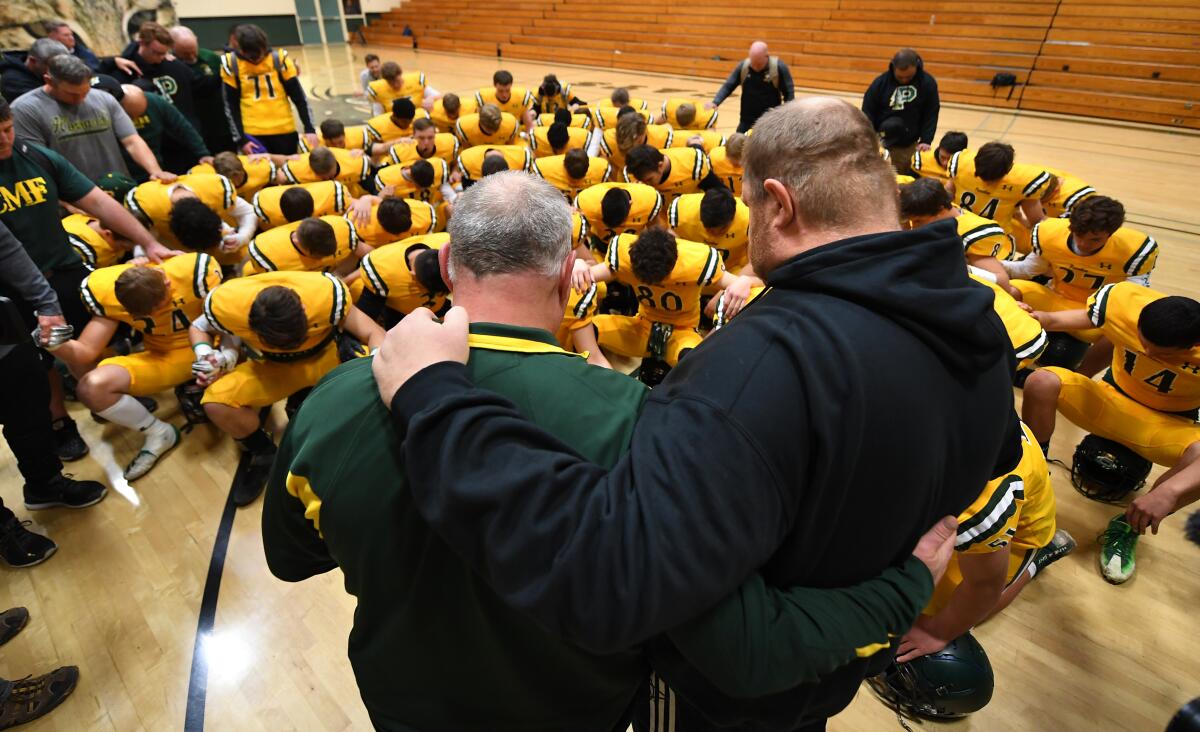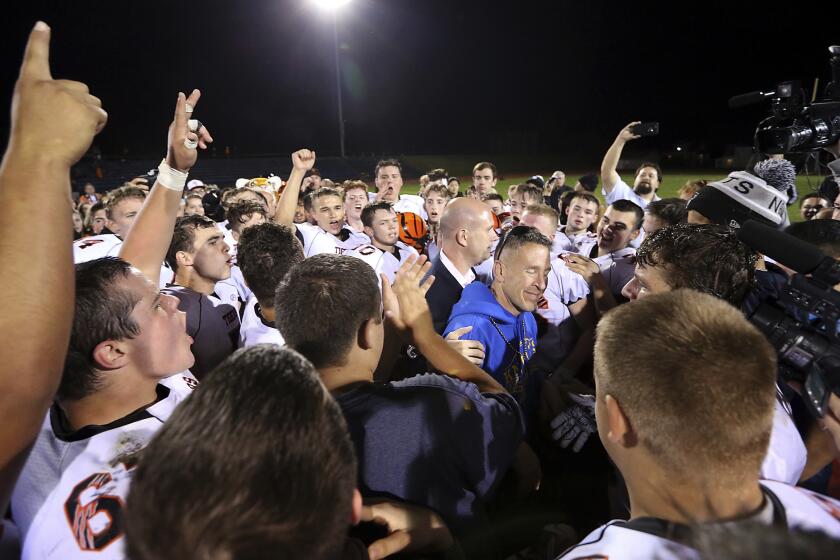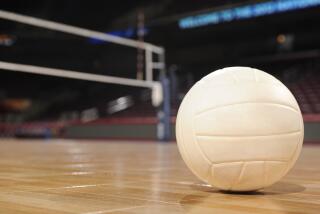Supreme Court school prayer ruling stirs debate over how far religion will seep into campus

- Share via
The U.S. Supreme Court’s decision to permit a high school football coach to pray on the field after games is expected to reopen a vigorous and probably tense debate among parents, educators and others over how far religion can enter public school grounds, California education and legal experts said Monday.
Conservatives and some Christian leaders praised the court’s action, saying it allowed for the personal religious expression of the coach and those who voluntarily followed him, a reasonable accommodation to religious and free speech rights. But civil libertarians and many educators said allowing a coach or any other school authority figure to lead a prayer amounted to the kind of establishment of religion that the Constitution forbids.
“The court has opened the door to prayer in schools more than at any time in the last 60 years,” said Erwin Chemerinsky, a constitutional law expert and dean of the law school at UC Berkeley. “There will be much litigation. And it is not at all clear where the court will draw the line.”
A 60-year-old decision by the high court to bar an official prayer in New York schools had created a bright line for school officials: that practices and policies on campus should have strictly secular purposes. Monday’s ruling has blurred that line and will invite additional challenges by those who want more room for religious expression in schools, said John Rogers, a professor of education at UCLA and an expert in training school administrators.
“One of the results of this decision is that it probably is going to open up more conflict in schools,” Rogers said. “It’s probably going to create more challenges for principals and other district leaders, as new efforts are made to bring religion into the space of public schools. In some school settings, religious minorities or people who are not affiliated with any religion are going to feel some sense of compulsion or some sense of silencing or alienation.”
Monday’s decision came in the case of Joe Kennedy, an assistant coach at Bremerton High School in Washington state. Kennedy began kneeling by himself on the 50-yard line after games to pray, though the sessions soon became highly publicized and drew crowds of players and spectators to the field.
The conservative majority said football coach Joe Kennedy’s prayers on the field were protected as free speech, and not an official promotion of religion.
When the prayers became a public event, school officials warned the coach that they could be seen as violating the Constitution’s ban on an “establishment of religion.” Kennedy was suspended when he refused to follow the district’s guidance. He was not rehired for the next year.
Lower courts ruled against Kennedy, but the conservative majority on the Supreme Court found that the coach’s prayers were protected under two other provisions of the 1st Amendment — the free speech clause and the “free exercise” of religion clause.
“The Constitution and the best of our traditions counsel mutual respect and tolerance, not censorship and suppression, for religious and nonreligious views alike,” Justice Neil M. Gorsuch wrote for the 6-3 majority.
The court’s action spurred a lively discussion Monday on a Facebook group for parents who support teachers in the Los Angeles Unified School District and are generally aligned with their union.
One parent cheered the protection of Kennedy’s free speech and religious freedom rights, saying that the coach never forced others to join in the prayer sessions. But several other parents objected, saying that players and students could feel ridiculed or excluded if they were in the minority who did not join in the prayers.
Other parents wondered how receptive the high court would have been to the freedom arguments if the coach in question had been a Muslim, who placed a prayer rug at midfield and bowed in prayers to Allah.
“I don’t know if this Supreme Court would take a decision this far if it were another religion besides Christianity,” said Tracy Abbott Cook, one of the parents in the discussion group. “And why does this coach have to bring religion into this moment in public? Maybe people want a break from religion and politics when they go to a sporting event. . . . Why muck it up?”
Los Angeles schools Supt. Alberto M. Carvalho said the district’s policy already made clear that employees are allowed to pray, but on their own time and in their own place. The district forbids prayers that would make students feel compelled to join, Carvalho said.
“To the extent that you engage in prayer, by yourself, outside of the actual [school] event — and you did not compel anyone to accompany you in prayer — then that is within the guardrails of free speech, which you do not lose when you enter a public school.” he said. “If it goes beyond that, it will continue to not be allowed.”
But even in the nation’s second-largest school district, it seemed apparent those guidelines aren’t uniformly followed.
Football coaches at three high L.A. Unified schools said they were aware of rules requiring separation of religion and school functions, though they said players would sometimes informally lead prayers, sometimes in small groups.
Stafon Johnson, football coach at Dorsey High, said he regularly leads prayers just before and after games. “I’m just praying for their comfort, praying for … injury-free, praying for other teams so that they can travel safely,” said Johnson, who said he finds the practice brings players comfort.
He said he references “God” in his prayers but considers it a universal term and that Muslim players and coaches “participated in their manner.”
Carvalho said that he would have to know details about the Dorsey High prayer sessions but that they sounded “inconsistent” with the district’s policy.
Ken Williams, an Orange County Board of Education trustee, applauded the court for its ruling, saying that the celebration of religious diversity and expressions of faith are central to the American identity.
“I totally understand that you cannot force someone to pray or believe in the same things that I believe in,” said Williams, a Christian. “I think that’s very American, but I also think religion is important. This nation was founded by men of religious faith.”
In the Central Valley’s Clovis Unified School District, board member Steven Fogg said he would support a change in policy to allow teachers and coaches to lead prayers at athletic events. The district previously allowed only students to lead prayers.
The district had for years opened school board meetings with a prayer, a routine discontinued after a federal appeals court ruled against the practice in 2018 in a case involving a school board in Chino Valley.
“I hope people aren’t threatened by prayer. They shouldn’t be,” said Fogg, who is Mormon. “Prayer should not be something that brings animosity, otherwise it’s a false prayer. We certainly do not want anyone to feel excluded. It should be something that brings people together.”
But lawyers who had argued against organized prayer on school grounds said the practice tends to become coercive, and exclusionary, when it is led by coaches and other authority figures. The ACLU of Washington noted that one of Kennedy’s players participated in the prayer against his own beliefs for fear of losing playing time if he declined.
“This decision strains the separation of church and state — a bedrock principle of our democracy — and potentially harms our youth,” said Taryn Darling, senior staff attorney for the ACLU of Washington.
“Some parties see a political game to be made from having our public schools be theaters for conflict,” Rogers of UCLA said. “And I think that’s to the detriment of public schools, which require some level of common purpose in order to advance our shared interest in developing the capacities of young people in serving the broader community.”
Monday’s decision did not overturn previous court rulings that forbid more direct intrusions of religion into the curriculum and the school day.
In 1962, the high court ruled in Engel vs. Vitale that the Board of Regents of New York could not impose a prayer on students. The court turned down the proposal from the New York educators, even though they argued their one-sentence prayer was nondenominational.
Justice Hugo Black found that the mere introduction of the prayer (“Almighty God, we acknowledge our dependence upon Thee, and we beg Thy blessings upon us, our parents, our teachers and our country. Amen.”) was, by its very nature, sufficient to constitute an illegal establishment of religion, even if participation in the prayer was not overtly coerced.
In subsequent decades, the Supreme Court would reject an Alabama law permitting a minute of prayer or meditation during the school day and prohibited prayers led by religious leaders at school graduation ceremonies. In 2000, the court also rejected a Texas school board’s policy that allowed students to decide, by majority vote, whether to have a student-led “invocation” at football games, graduations and other school gatherings.
“The religious liberty protected by the Constitution is abridged when the state affirmatively sponsors the particular religious practice of prayer,” Justice John Paul Stevens said in the 6-3 opinion nixing the school prayer plan. Stephen Breyer is the only justice remaining on the court who concurred in that opinion. He is set to retire this summer.
More to Read
Sign up for Essential California
The most important California stories and recommendations in your inbox every morning.
You may occasionally receive promotional content from the Los Angeles Times.














